2022 Showcase Winners
Read about the Common Home Arts Showcase and other Earth Commons art initiatives in “3 Ways Hoyas Are Celebrating Earth Day Through the Arts”
Read on Georgetown.eduFatigue, courage, futility, hope and perseverance: the Earth Commons welcomes the Georgetown community to express their hopes and feelings about our changing world and its inhabitants through the Common Home Arts Showcase.
Our fourth-annual Common Home Arts Showcase, this year offered in partnership with the Lannan Center for Poetics and Social Practice, features the theme of “Climate & Creativity”, a theme that complements that of this year’s Voices on the Environment series event, Writing Climate: 2025 Lannan Symposium.
End of carousel collection.
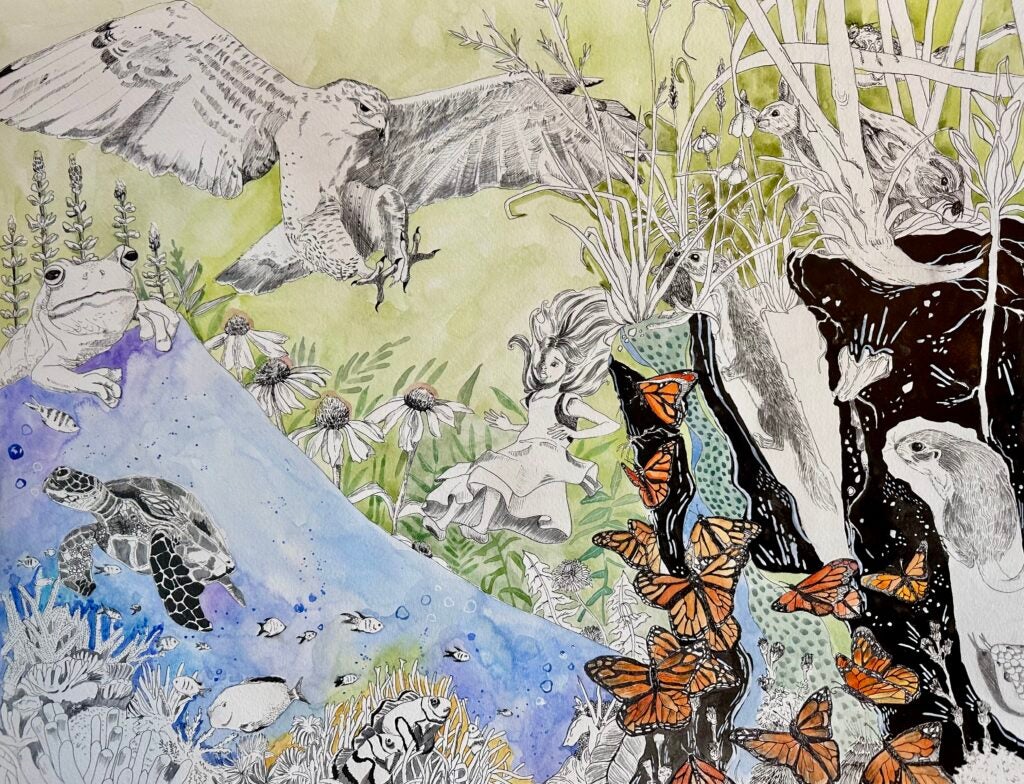
“The Blueprint of Wonderland” by Katie Shen
“As an artist and aspiring molecular biologist, I am fascinated by the concept of using nature as a source of creativity. Nature holds billions of years of evolutionary solutions to challenges like population survival and resource allocation. Through a process known as biomimicry, we can apply these mechanisms to solve modern problems, including those related to climate change. My primary aim was to encourage reverence towards nature and to foster a sense of responsibility and stewardship for our home. Inspired by Alice’s absurd and magical journey through Wonderland, my Alice navigates the collision of diverse ecosystems in a whimsical and dreamlike storybook style. I drew from my own curiosities about the natural world, depicting organisms from a micro to macro level. Biomimicry and investigating the interconnectedness of ecosystems offer powerful tools for addressing environmental degradation. They shift our approach from one of exploitation and resource depletion to one of restoration and integrative problem-solving. The transcendent beauty of nature offer us a golden blueprint for reimagining our human impact on this planet.”
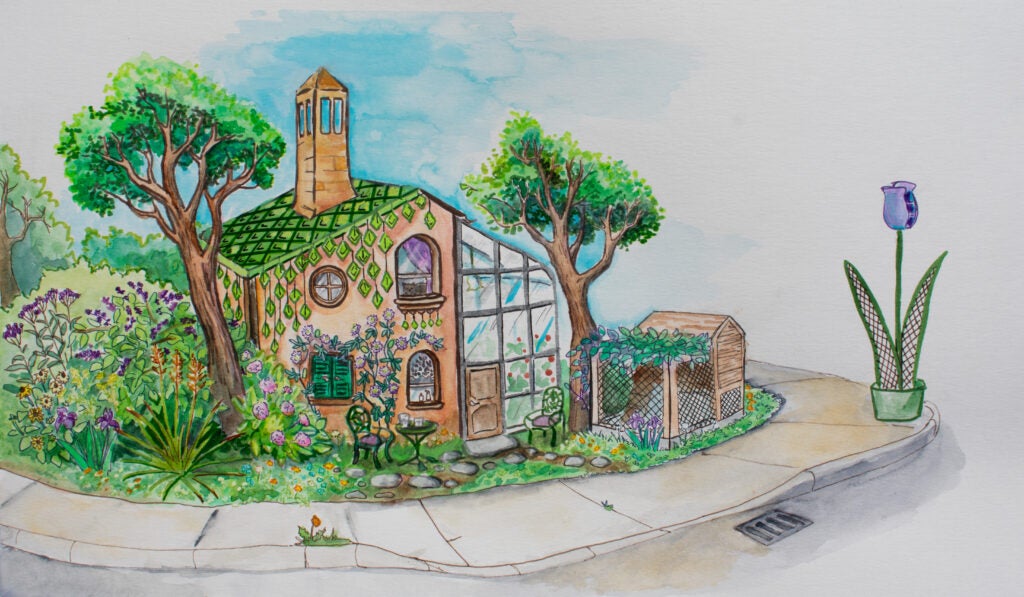
“Dreaming House No. 2” by Alexi Scheiber
“‘Dreaming House No 2,’ from the series Artifacts from the Dreaming World is an imagined solarpunk home. The Monoculture lawn is replaced by luscious native plants that cool the surrounding earth more effectively, and protect the home from flooding better than monoculture lawns, alongside attracting pollinators and forming wildlife habitats. The chimney has been converted into a wind tower. Modular solar panels are decorative and functional, forming stained glass panels and bright green roof tiles. An unobtrusive and safe-for bird wind turbine shaped like a tulip is placed down the street. A greenhouse and chicken coop allow for the homeowners to sustainably contribute to their food system. The Dreaming World is a larger, ongoing series of utopian visualizations.”

“In Memoriam” by Eileen Wold
“The painting “In Memoriam” shown with two small collage works titled “Stall” are part of a series I created called Arctic Amplification. A term used by the scientific community to describe the increased rate at which the Arctic region is warming compared to the rest of the planet. This is due to white ice melting, leaving more dark water to absorb heat from the sun and increase overall temperatures. I worked with Dr. Hailong Wang, a scientist at the Pacific Northwest National Laboratory to understand the links between Glacial loss and extreme weather across the United States. We collaborated on a gallery presentation to accompany the exhibition and this painting is currently on display in the Gallery at Loyola University Maryland.”
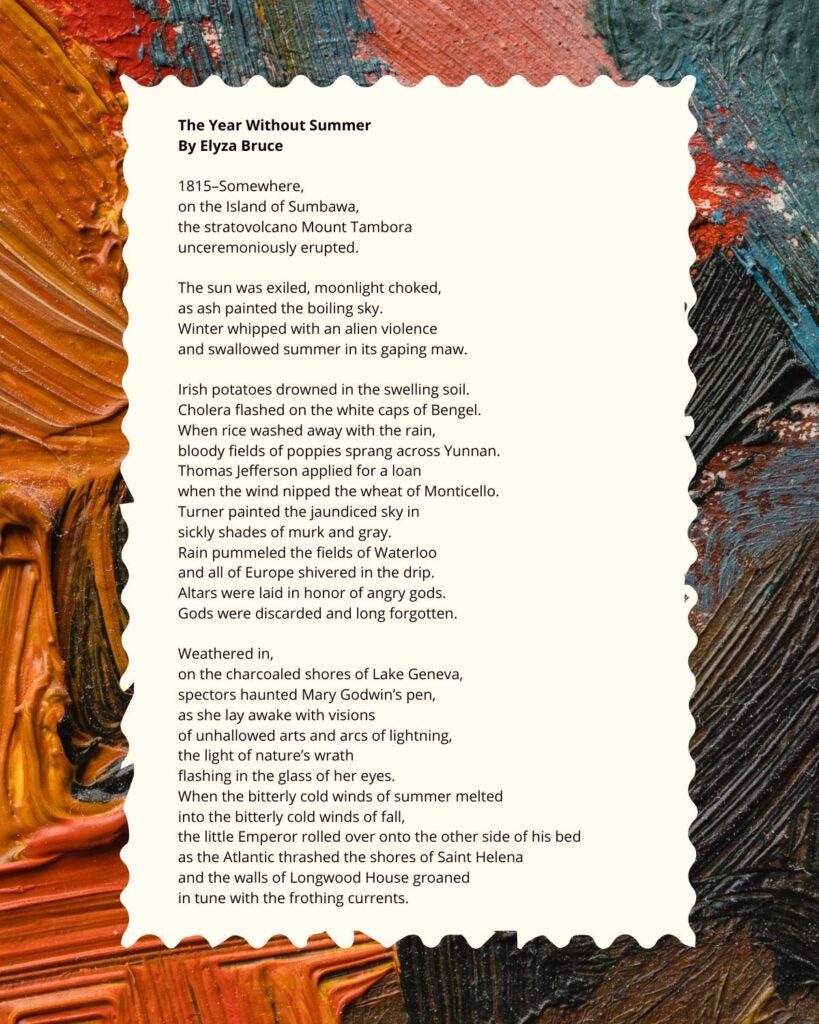
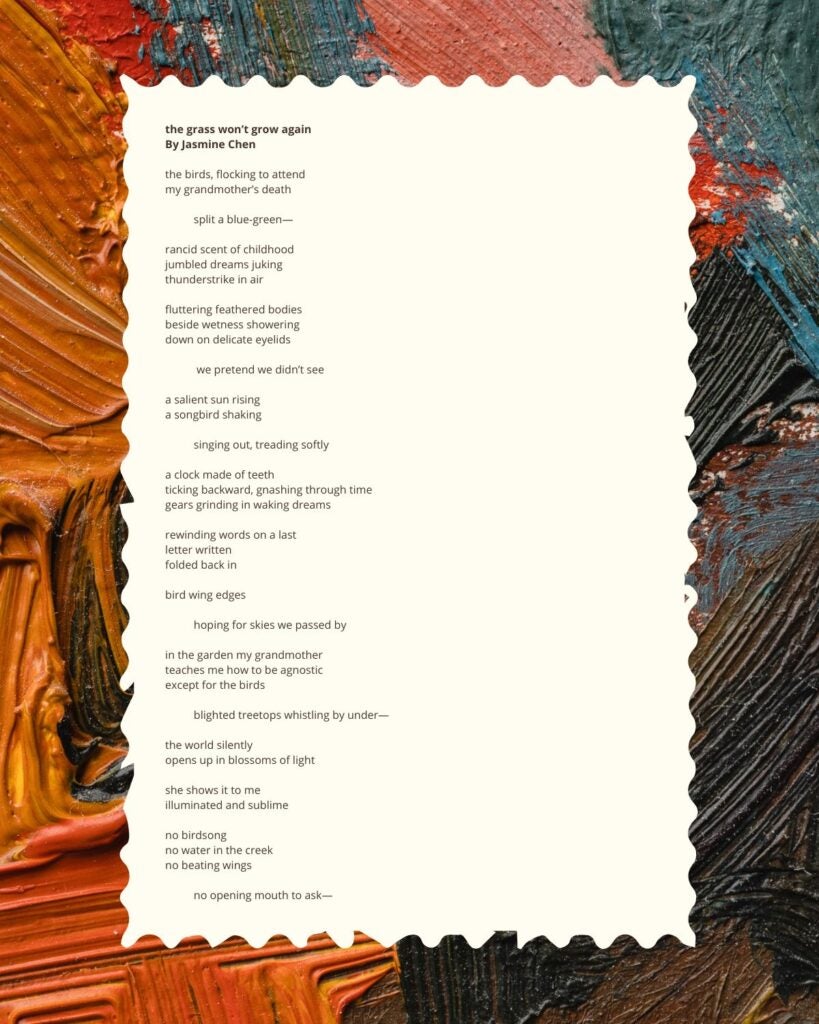
“injustice, joy” by Theo Daniels
A four-and-a-half-minute reflection on environmental justice in the United States as
seen through the lens of our nation’s capital. The film juxtaposes unkempt green spaces with the crumbling infrastructure of forgotten communities. In this short, I sought to explore the idea of what justice truly looks like through conflicting political systems and embedded community experience.
The 2024 theme for the Common Home Arts Showcase was “Life on Earth,” inviting photographers to depict the beauty of wildlife, celebrate diverse cultures, and to express their views on the environment and sustainability through original, compelling photography in three categories: Wildlife, People and Landscapes.
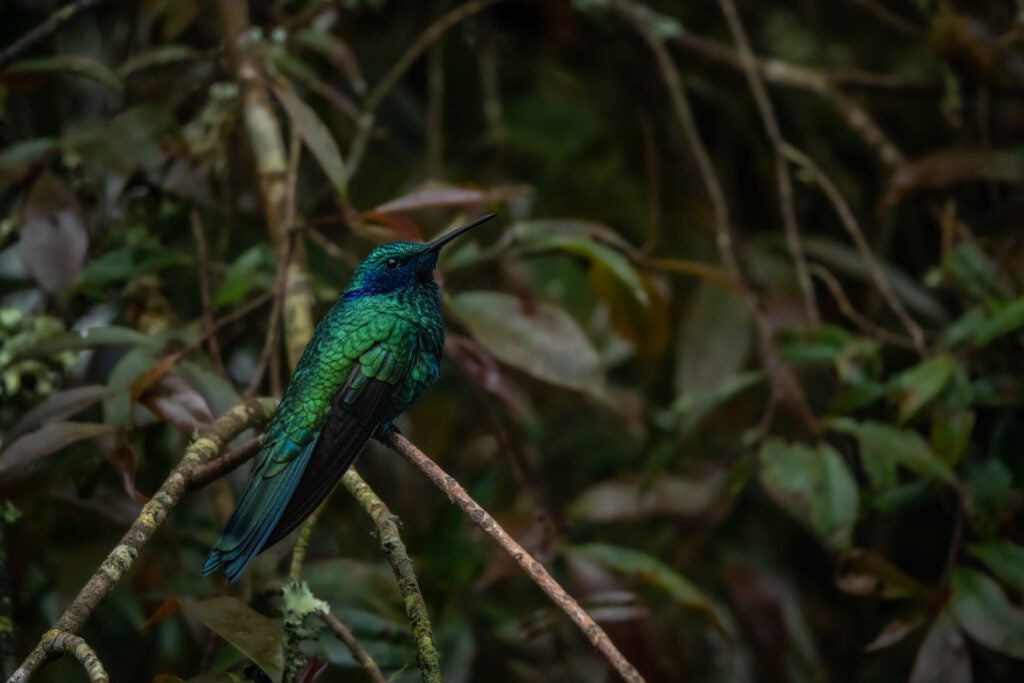
“Colibrí Perchado” by Sergio Rodriguez Cifuentes
“I took this photo one day while walking in my house’s backyard in Bogotá, Colombia. Seeing birds in my backyard became the gateway for a deeper interest in photographing the world around me. Pictured is a Sparkling Violetear.”
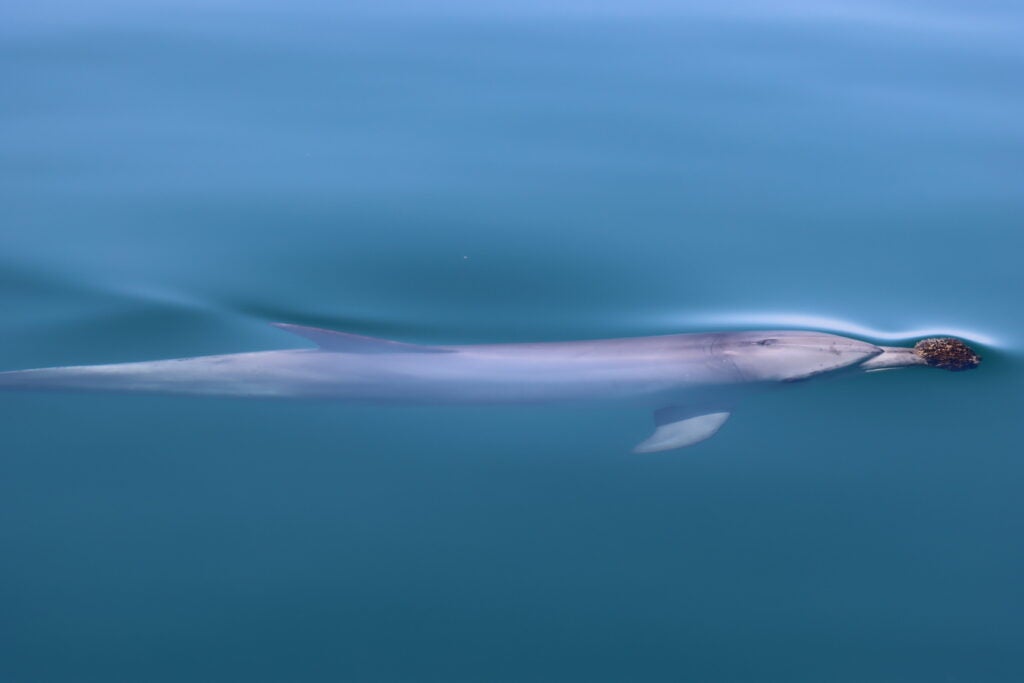
“Showoff!” by Meredith MacQueeney
In Shark Bay, Western Australia, a dolphin named Whopper ascends with a very special lump around her beak—a sponge tool. “Spongers” choose a round, basket-shaped sponge from the seafloor and wear it like a glove while they ferret out bottom-dwelling fish. Wearing the sponge likely protects the skin from abrasion and spiny fish. Sponging is a highly specialized foraging tactic utilized by only a small group of dolphins in Shark Bay. This tactic develops much later than other foraging tactics and sponging skills must be honed over decades. Mothers pass down the tradition to their calves. Interestingly, all daughters will learn the technique from their mothers but only about half of sons become spongers. The mother-calf bond is fundamental to all dolphin and whales societies, where mothers hold ecological knowledge and maintain their unique cultures. Whopper loves to approach our research vessel and “bow-ride” the pressure wave we generate. She frequently brings her sponges along with her, giving us a peek into her rapidly changing world. Human and animal cultures worldwide are threatened by climate change; but for now, Whopper spends her days swimming gracefully through the cerulean blue and showing off her carefully selected sponges.
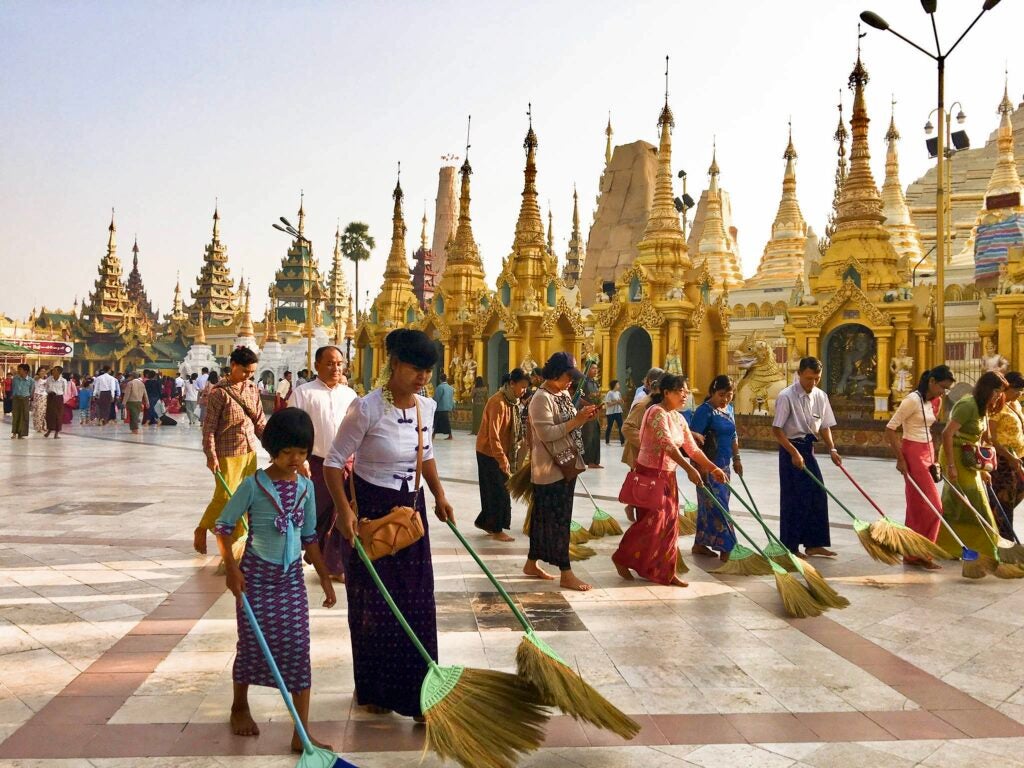
“Merit” by Yoon Yati Oo
As Myanmar’s most sacred Buddhist site, the Shwedagon Pagoda garners hundreds of visitors daily, both local and foreign. Amidst the hustle and bustle of the crowd, a serene spectacle unfolds each evening as a dedicated group of volunteers meticulously sweep the vast marble terrace. Their synchronized efforts symbolize not just cleanliness, but a meritorious devotion to the preservation of the pagoda’s sanctity.

“Bisan Owda” by Samraa Smadi
Bisan epitomizes the essence of resilience amid adversity, serving as a beacon of hope in times of darkness. While addressing environmental crises is crucial, we must prioritize the plight of individuals, particularly the most vulnerable, who bear the brunt of human-caused suffering. Environmental advocacy must encompass a deep love and empathy for humanity. Let us remember that our fight for justice extends to all beings, including people, children, and those burdened by hardship. True activism requires us to listen to the voices of those in need and stand in solidarity with them.

“Sunrise on Everest” by Katie Meyer
“The world was silent atop Kala Patthar, Nepal – only my breathing kept me company. Each arduous step was followed by an equally arduous breath in the oxygen-deprived air. As I paused to grab my water bottle, I momentarily diverted my gaze from the path and gasped at the view. There, in front of me, was sunrise over Mount Everest. The highest place on Earth was illuminated in purples and yellows, emerging from darkness, signaling to the world that it was dawn. I found myself humbled by the the silent fortitude of the Himalayas, awed at the power and beauty she possessed.”
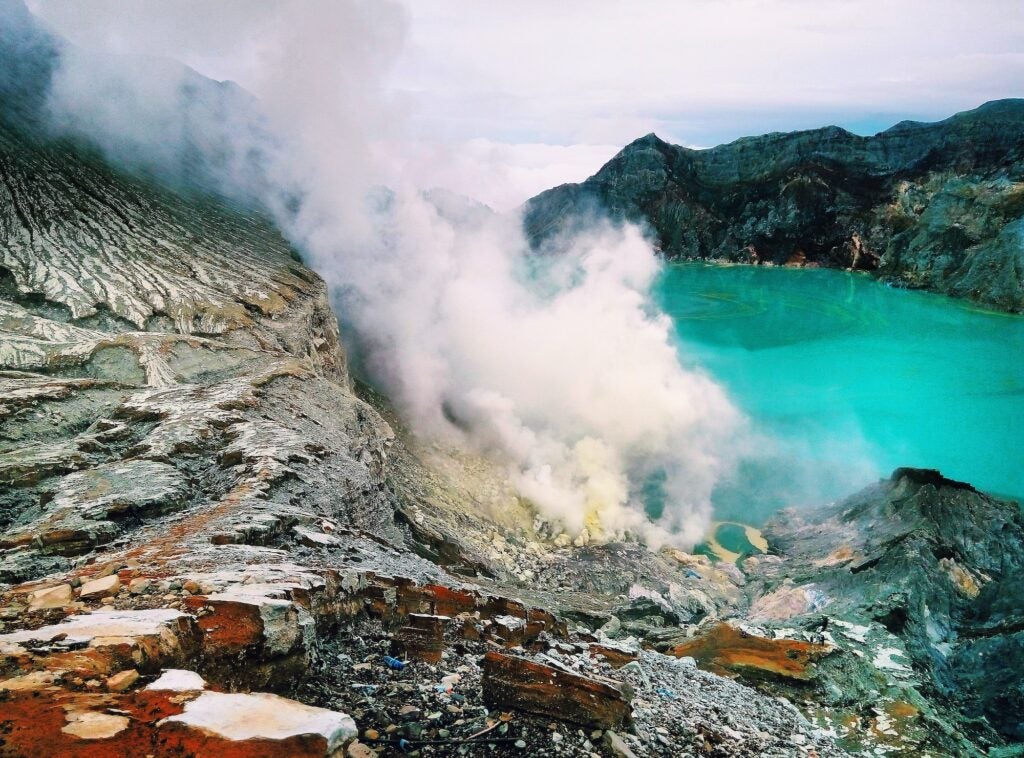
“Ijen Volcano, Indonesia” by Ksenia Dubova
This photograph shows the rugged terrain of Mount Ijen, an active volcano located in East Java, Indonesia. It is renowned for its visually striking blue fire, a result of sulfuric gases igniting as they escape into the atmosphere. The main feature is the large acidic crater lake that possesses a surreal turquoise hue, contrasting sharply with the surrounding barren landscape. In this otherworldly setting, Indonesian workers engage in sulfur mining, enduring harsh conditions to extract the valuable mineral.
“I saw this terrain after the exhausting night hiking and the image stuck with me forever. The raw beauty of this scene is a testament to Earth’s dynamic forces at work.”
The Common Home showcase called upon photographers to express their views on the environment and sustainability through original, compelling photography that carries a striking message and sparks discussion. For the second year of our showcase, the theme was, “People, Water, Land.“

“A Dawn Diversion,” by Brian Griffiths
“A Dawn Diversion,” by Brian Griffiths won first place in the “People” category. The photograph depicts a girl in a canoe, creating a donut-shaped wake as she paddles in circles. “I was sitting in my hammock watching the sun rise over the river when I heard a screeching laugh of delight from behind me,” writes the photographer. “I turned around and saw my neighbor sitting on the edge of her canoe, paddling in circles as fast as she could… I laughed and ran outside with my camera, and she paddled over and acquiesced to my request for a portrait. The soft glow of dawn beautifully lit this moment of peace and fun.” The photograph serves as a reminder that our land and water must be preserved for future generations to enjoy.

“Respite” by Sadie Marsman.
The second winning photograph for the People category is titled “Respite,” and was submitted by Sadie Marsman. The photograph captures a group of women seeking refuge from the scorching heat of Madrid. “The heat in Madrid was quite high this day—nearly 40 degrees Celsius,” writes Marsman. “This group of women found respite at a reflecting pool, enjoying each others’ company and cooling off with the water.”
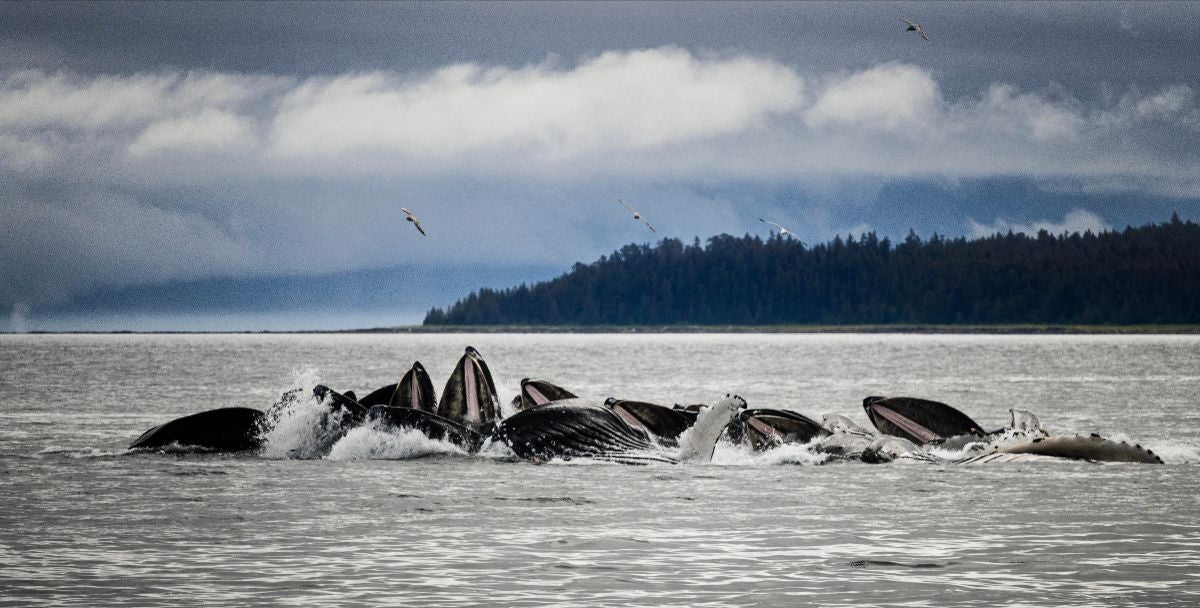
“Humpback Whales” by John Matuszewski
“Humpback Whales” by John Matuszewski depicts a group of Humpback whales engaged in a coordinated feeding technique known as “bubble-net feeding.” In the photograph, the whales can be seen surfacing together with their mouths open, creating a ring of bubbles around a school of fish. The bubbles serve to herd the fish into a concentrated area, making it easier for the whales to feed. The image perfectly captures the awe-inspiring moment and serves as a reminder of the importance of preserving the delicate balance of our ocean ecosystems.
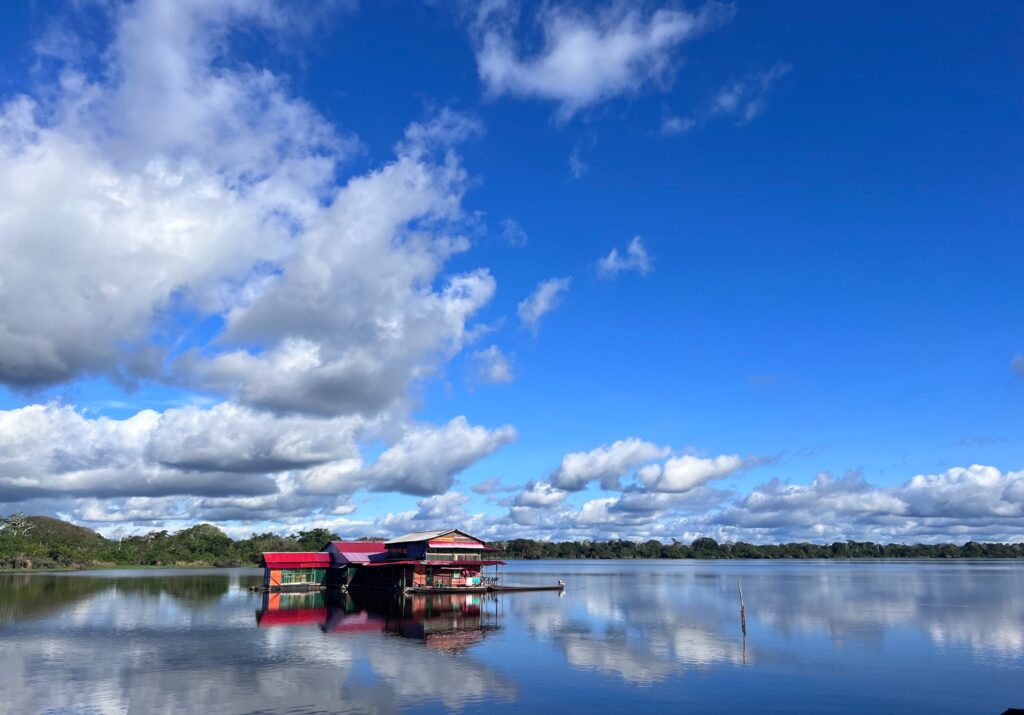
“The Ecosystem Home” by Katherin Vargas Henao
Katherin Vargas Henao’s photograph depicts a sustainable house design situated on mirror-clear waters reflecting the sky over the Colombian Amazon. According to Vargas Hanao, the house design allows for sustainable living while creating fewer negative environmental impacts. “This house does not require land for construction, which can help preserve natural ecosystems and prevent deforestation and habitat loss,” writes the photograher.

“Woman Picking up Yak Excrement” by Zhenghao Wang
Top honors in the “Land” category go to Zhenghao Wang for “Woman Picking up Yak Excrement.” The photographer writes that modern civilization changes the lives of the locals in Tibet, but they still maintain some traditions. “The woman in the picture is picking yak excrement, which can be used to lit fire. The fresh poop stinks, but after being exposed to strong sunlight for a long time, poop will dry out with no smell at all. Furthermore, a good piece of poop can be lit for a long time. Yaks are not kept on farms but live freely in nature, and that is why locals need to walk everywhere to pick up excrement.”
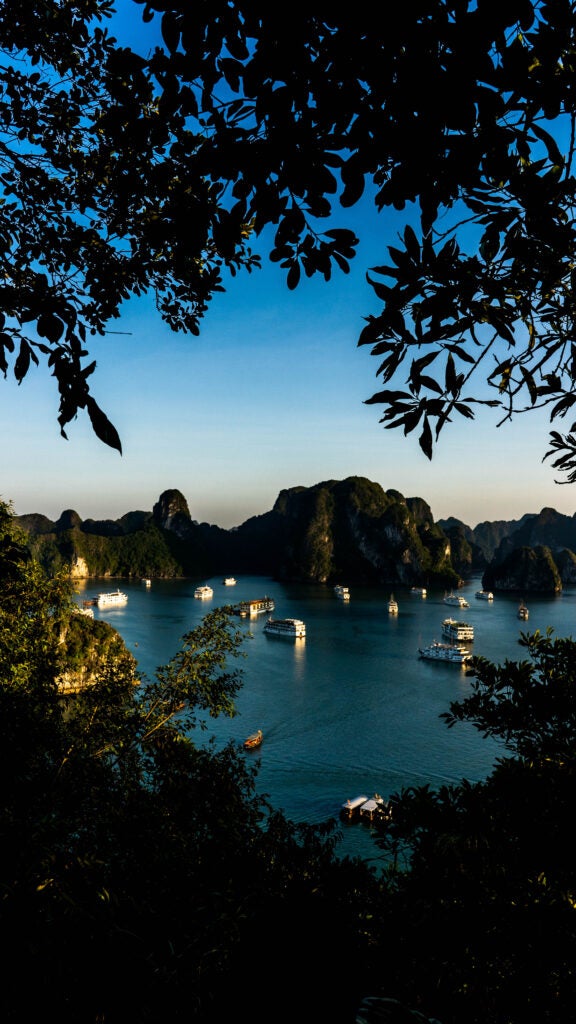
Jean-Paul Nguyen’s photo, “Boats of Ha Long Bay”
Jean-Paul Nguyen’s photo, “Boats of Ha Long Bay,” earned second place in the “Land” category. He writes, “Despite Vietnam’s fast development, the locals of the inner areas of the country continue to rely on fishing and farming as ecotourism grows. I wanted to characterize their lifestyle while putting an emphasis on the great nature around.”
The “Land, Water, People” theme of the contest encouraged photographers to approach the themes in their own unique ways, and the winning photographs did just that. The photographs not only display the beauty of our environment but also highlight the challenges we face in creating a sustainable future.
Read about the Common Home Arts Showcase and other Earth Commons art initiatives in “3 Ways Hoyas Are Celebrating Earth Day Through the Arts”
Read on Georgetown.edu2022’s inaugural theme, in conjunction with the institute’s collaborative “Voices on the Environment” series, was “Intergenerational Justice.” Top submissions link the theme of intergenerational justice with the environment through highly original, compelling artwork that conveys a strong message and sparks discussion about the environment and our relationship to it.
“Intergenerational justice,” focuses on the duties that present generations have towards future ones. Climate change raises particularly pressing issues, such as which risks those living today are allowed to impose on future generations and how available natural resources can be used without threatening the sustainable functioning of the planet’s ecosystems.
The showcase featured 2 categories, the first, “Traditional,” includes graphic/studio arts, such as photographs, paintings, and digital drawings); the second, Freeform, includes written and multimedia arts, such as poems, videos, audio and filmed performances.
Isabella Callagy (C’23), won first place in the “Traditional” category for her painting, “Holding On” (oil on canvas). “This composition ties together art, healing, nature and disaster,” she wrote. “It is up to my generation to make serious changes in their daily lives that impact the environment in the hopes to help future generations have access to water. There is no life without water.”
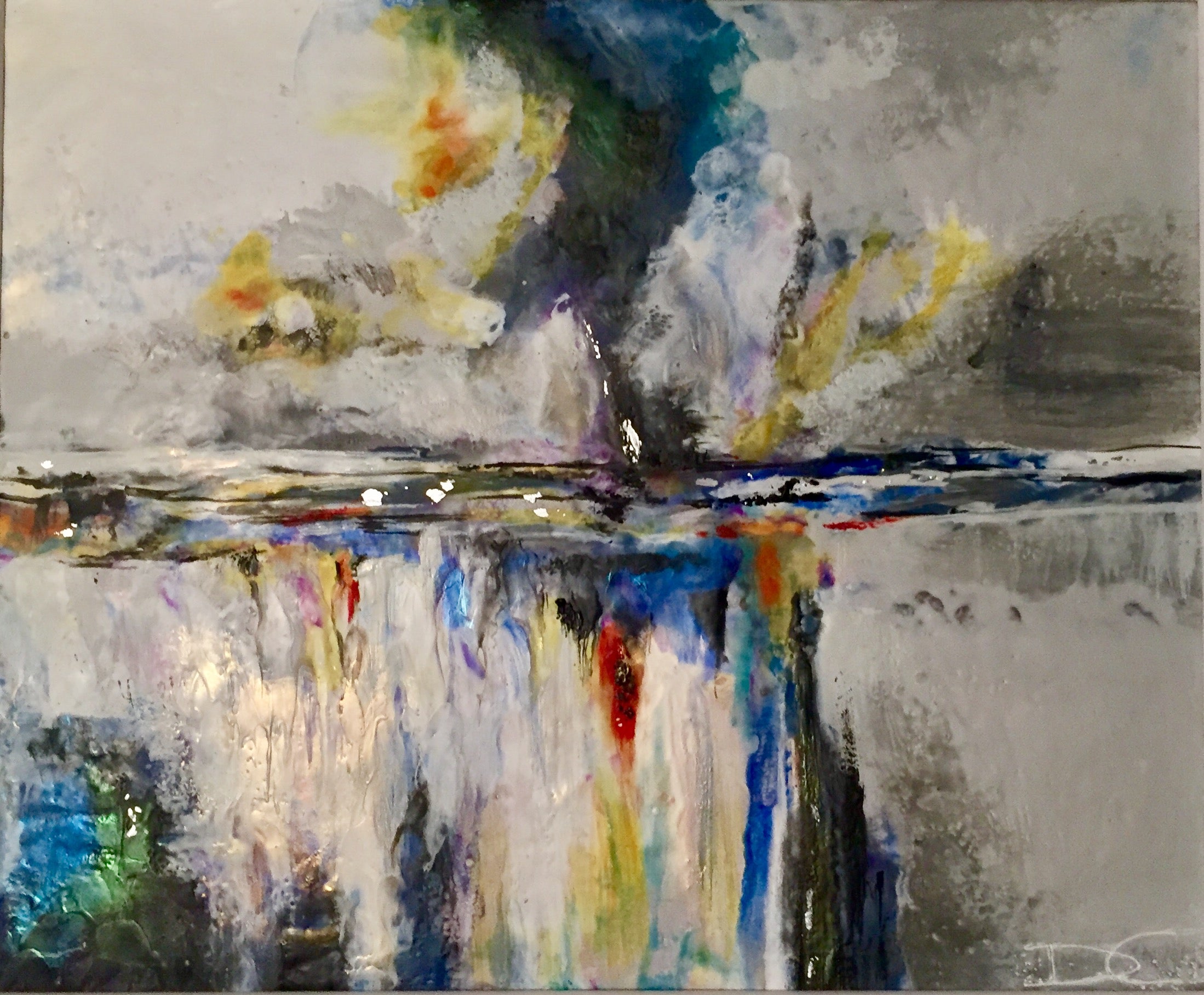
“A Black Future” by Dany Garza Mendoza
Dany Garza Mendoza (MSFS Candidate ’23) earned second place in the “Traditional” category for her painting. “My piece is called ‘A Black Future,’ and it’s inspired on the Deepwater Horizon BP oil spill in April of 2010,” writes the painter. “The artwork is meant as a warning: a visual representation of the devastating effects that humans have had on our planet, and the potential future if we continue with the status quo.
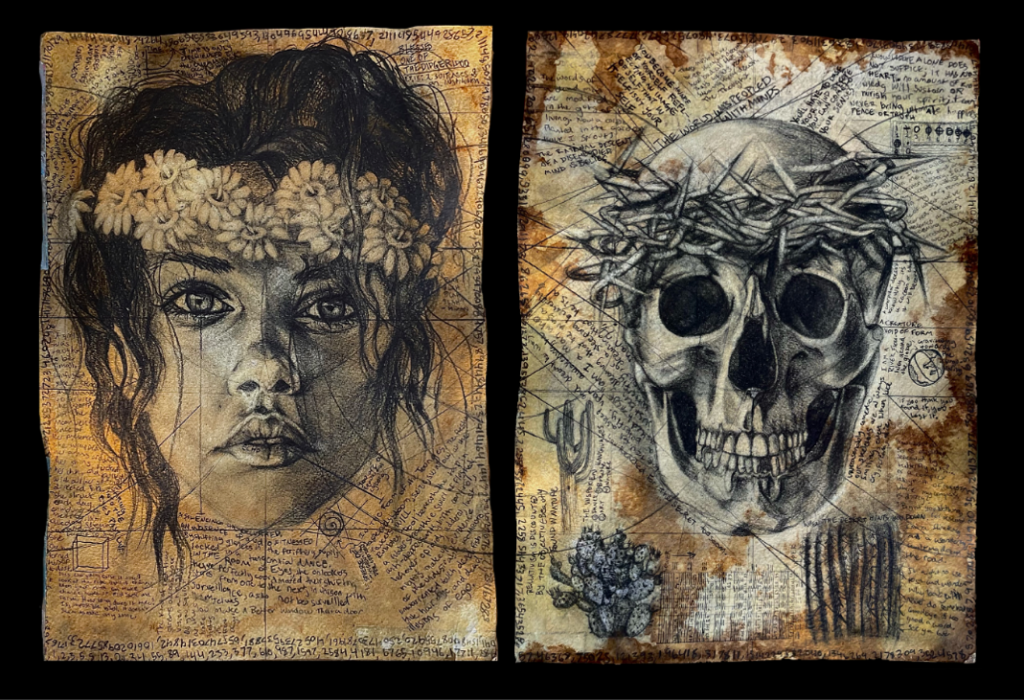
“The Self through Time” by Peris Lopez
Peris Lopez (SFS ‘23) earned third place in the “Traditional” category with this diptych drawing created on paper soaked in water, dirt creosote, mesquite leaves, and other desert plants.
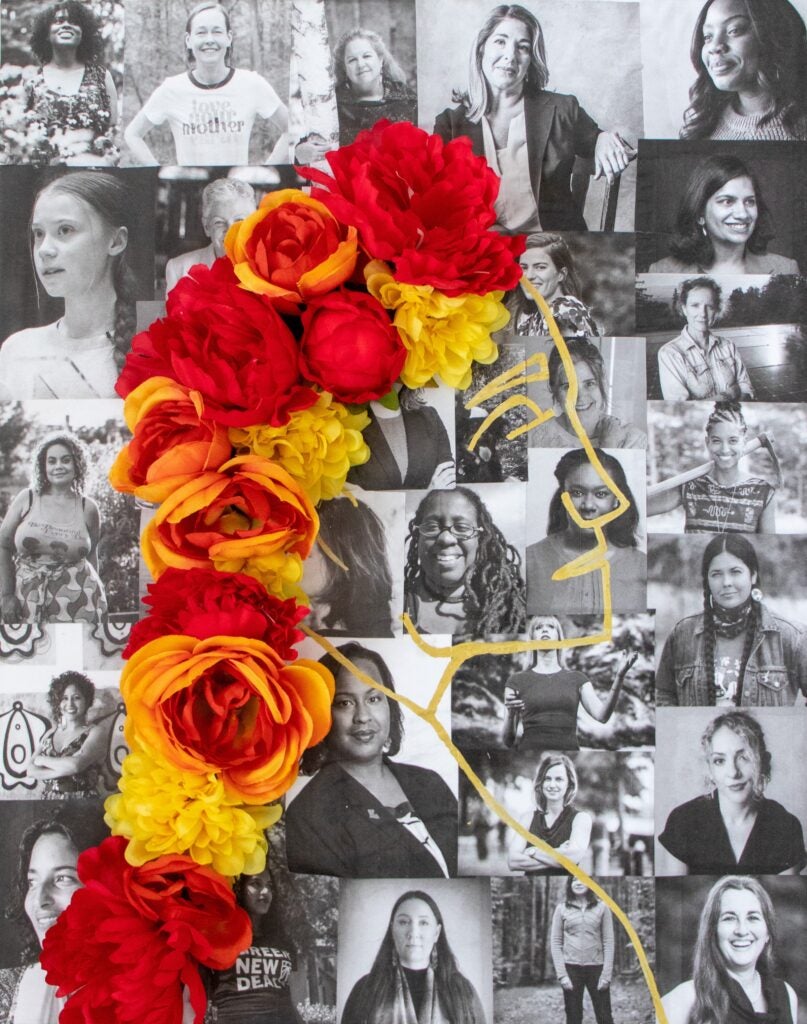
“Female Faces of Change” by Victoria Smith (C ’22)
The first place submission for the “Freeform” category is a collage by Victoria Smith (C’22) that features black and white photograph, pen and ink, and faux flowers. The collage depicts women who have been instrumental in environmental advocacy, including Eunice Newton Foote, a scientist and feminist whose research in the 1800s predicted the impact of greenhouse gases. “Foote was a pioneer in the environmental and women’s rights world,” Smith notes, “so I wanted to connect her to women in the present day as this journey is all connected with many different branches for people to take,” she wrote. “Many more women to come will be part of this intergenerational journey for climate justice.”
The planterbed flowers are bolder than I
Or perhaps just more naive
Undressing and sharing their color with the pale spring sky Unafraid of another freeze
Unaware the seasons aren’t dependable anymore
Still
I smile down and greet them
Like the old friends that they are
Forsythia, daffodil, hyacinth
The chosen ones I learned from the nursery And planted with my dad
I wonder where they grow wild
Anywhere?
The crocus and bluebell and buttercup
Are less ruly
They dance in the yard and play hide and seek In the woods of Rock Creek Park
All delights.
The environmentalist to nihilist pipeline Scares me. Better to not see
The magnolia bravely let her guard down And rejoice until I remember
That urban trees live shorter lives Than their wild relatives
It is risky to root for the underdog
I think gardens are beautiful
But will I feel that we lost if they’re all we have left? Probably.
Perhaps the caged tree is a sacrifice
Perhaps the picture of resilience
Who am I to say
I don’t plan to bring children into such an uncertain world But if I did
I would want to introduce them to the bluebells
So they could learn
To bloom on their own terms.
-Shelby Gresch (C’22)
Second place “Freeform” submission
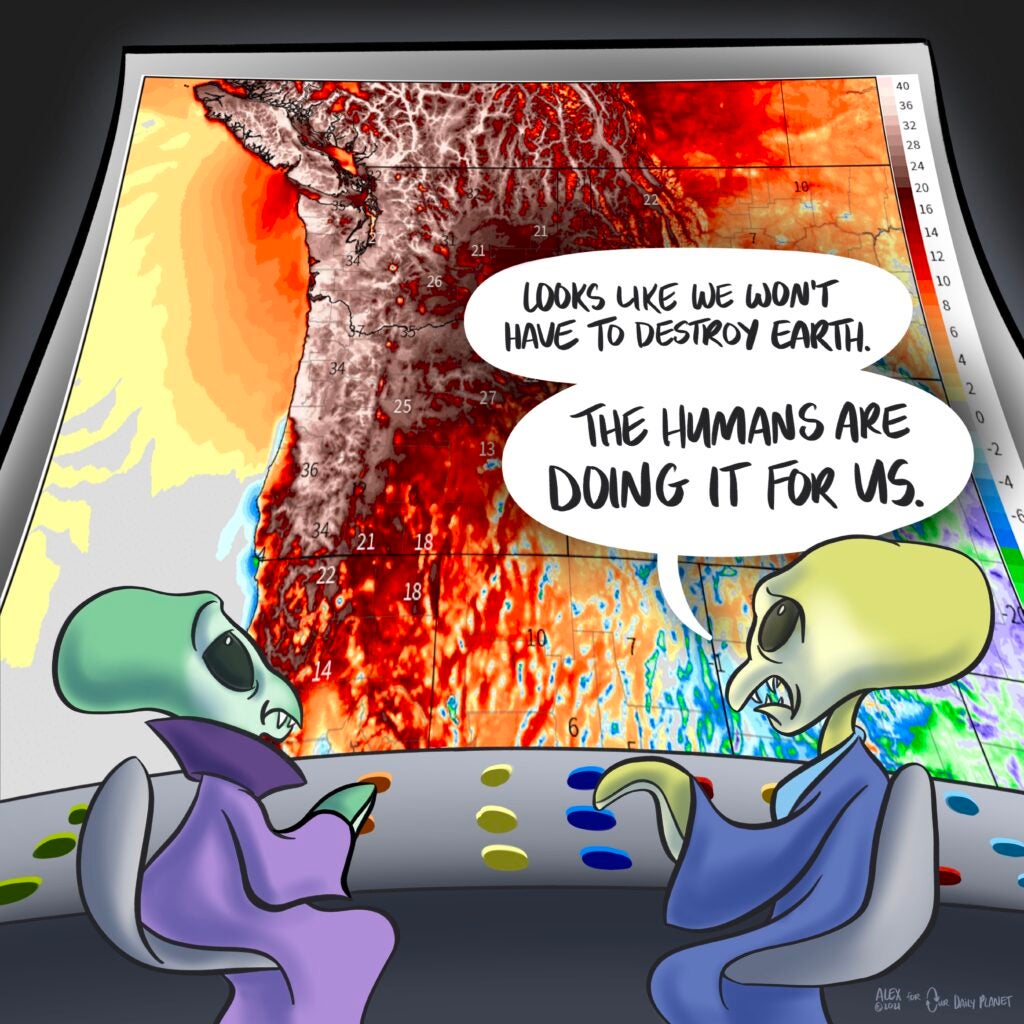
“The Humans Are Destroying Earth For Us” by Alexandra Bowman (C’22)
The third place submission in the “Freeform” category is “The Humans Are Destroying Earth For Us” by Alexandra Bowman (C’22), digital media, 2021. The illustration was originally created for Our Daily Planet.
2022 judges included Dr. Peter P. Marra (Director of the Earth Commons), Ian Bourland (Assistant Professor, cultural critic and historian of global contemporary art), Michelle Wang (Associate Professor in Art History with a specialty in Buddhist and silk road art of northwestern China), Marion Cassidy (Common Home magazine student editor), Justine Bowe (Earth Commons Director of Communications and painter), and Caitlin Nasema Cassidy (ECo Artist-in-Residence).